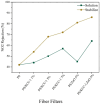Preparation of an innovative series of respiratory nano-filters using polystyrene fibrous films containing KCC-1 dendrimer and ZnO nanostructures for environmental assessment of SO2, NO2 and CO2
- PMID: 38444973
- PMCID: PMC10913408
- DOI: 10.1039/d4ra00176a
Preparation of an innovative series of respiratory nano-filters using polystyrene fibrous films containing KCC-1 dendrimer and ZnO nanostructures for environmental assessment of SO2, NO2 and CO2
Abstract
Air pollution has become a major challenge that threatens human health. The use of respiratory filters is one of the proposed solutions. In this study, using polystyrene (PS) fibers and various nanomaterials, improved respiratory filters were fabricated to remove air pollutants. In this context, ZnO nanoparticles (ZnO NPs) integrated into dendritic structures of KCC-1 silica were used to improve the filters' ability to absorb pollutants. For the first time, the removal of gasses by modified filters with a novel polymeric nanocomposite (PS/ZnO-KCC-1) stabilized on the surface of respiratory filters was investigated. Moreover, two different methods including stabilized- and solution-based techniques were used to prepare the filters with different amounts of ZnO NPs and their efficiency was evaluated. All synthesized nanocomposites and developed filters were characterized by FT-IR, FESEM, TGA and XRD methods. The successful stabilization of nanostructures on the fibers was proved and the performance of the fibers was investigated with some tests, such as pressure drop and removal of suspended particles and CO2 (89%), NO2 (86%), and SO2 (83%) gases. PS/KCC-1-ZnO (5%) has better performance than other prepared fibers. The results showed that the removal of suspended particles in the filter containing ZnO and KCC-1 (M5) nanostructures was improved by 18% compared to the filter consisting of polystyrene fibers. The pressure drop increased with the addition of nanostructures and reached 180 Pa in the M5 filter. The filter containing ZnO NPs showed antibacterial activity against Staphylococcus (S.) aureus and Escherichia (E.) coli as Gram-positive and Gram-negative model bacteria using the Agar disk-diffusion method. Based on the results, the use of improved respiratory filters is recommended as an effective solution for combating air pollution and protecting human health.
This journal is © The Royal Society of Chemistry.
Conflict of interest statement
There are no conflicts to declare.
Figures














Similar articles
-
Green Synthesis of Highly Dispersed Zinc Oxide Nanoparticles Supported on Silica Gel Matrix by Daphne oleoides Extract and their Antibacterial Activity.Iran J Biotechnol. 2021 Jan 1;19(1):e2598. doi: 10.30498/IJB.2021.2598. eCollection 2021 Jan. Iran J Biotechnol. 2021. PMID: 34179191 Free PMC article.
-
The Decoration of ZnO Nanoparticles by Gamma Aminobutyric Acid, Curcumin Derivative and Silver Nanoparticles: Synthesis, Characterization and Antibacterial Evaluation.Nanomaterials (Basel). 2021 Feb 9;11(2):442. doi: 10.3390/nano11020442. Nanomaterials (Basel). 2021. PMID: 33572431 Free PMC article.
-
ZnO-Impregnated Polyacrylonitrile Nanofiber Filters against Various Phases of Air Pollutants.Nanomaterials (Basel). 2021 Sep 6;11(9):2313. doi: 10.3390/nano11092313. Nanomaterials (Basel). 2021. PMID: 34578627 Free PMC article.
-
Enhanced anti-bacterial activities of ZnO nanoparticles and ZnO/CuO nanocomposites synthesized using Vaccinium arctostaphylos L. fruit extract.Artif Cells Nanomed Biotechnol. 2018;46(sup1):1200-1209. doi: 10.1080/21691401.2018.1448988. Epub 2018 Mar 11. Artif Cells Nanomed Biotechnol. 2018. PMID: 29527924
-
Green synthesis of cellulose nanocrystal/ZnO bio-nanocomposites exerting antibacterial activity and downregulating virulence toxigenic genes of food-poisoning bacteria.Sci Rep. 2022 Oct 7;12(1):16848. doi: 10.1038/s41598-022-21087-6. Sci Rep. 2022. PMID: 36207384 Free PMC article.
References
-
- Zhang Z. Zhang G. Su B. Socio-Econ. Plan. Sci. 2022;83:101167.
LinkOut - more resources
Full Text Sources

